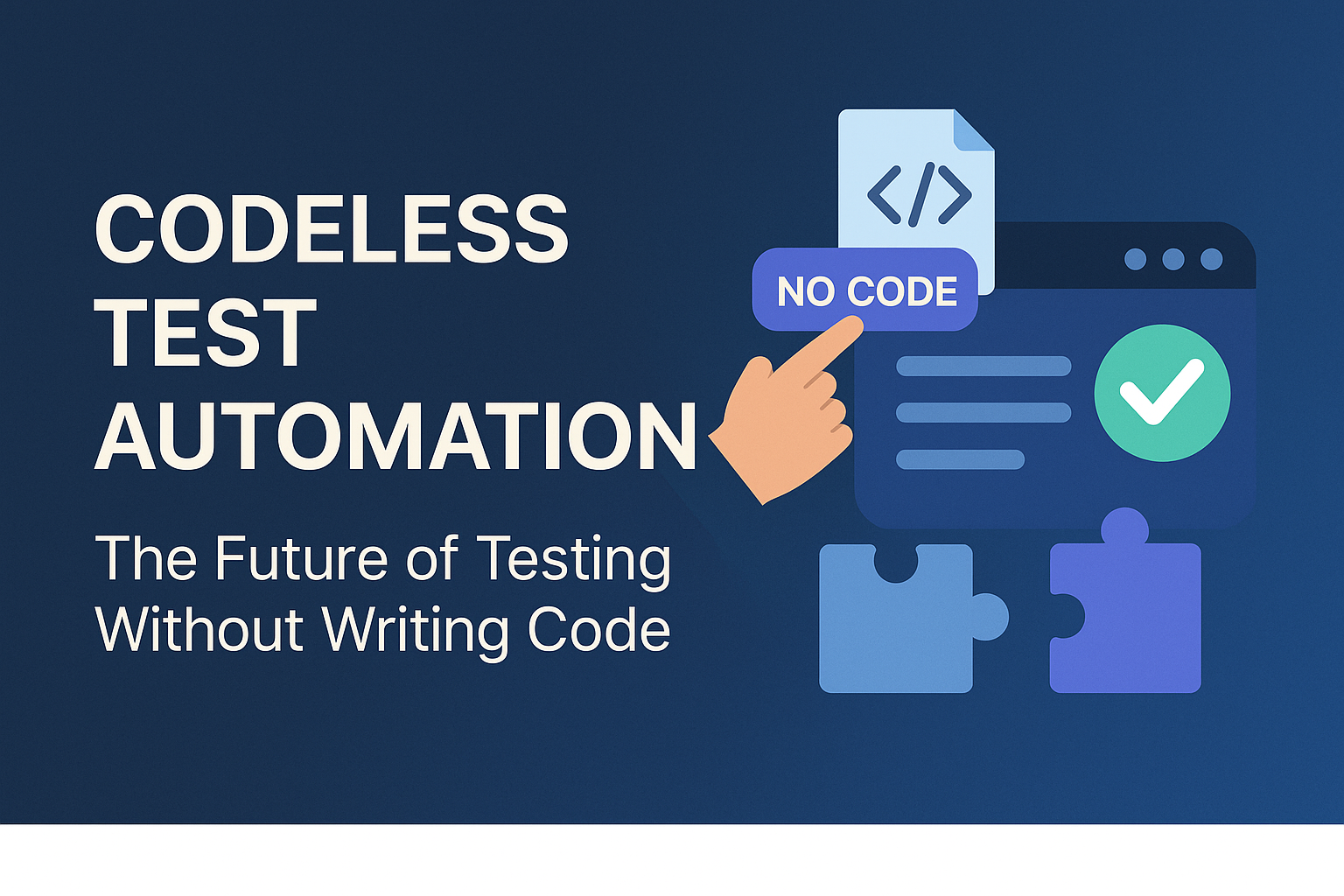Last updated on November 18th, 2025 at 04:10 am
Test automation no longer requires deep coding knowledge. With codeless test automation, teams can now create reliable automated tests without writing a single line of code. This new approach is transforming how QA teams work.
Codeless platforms utilize drag-and-drop interfaces, natural language processing, or record-and-play features. These tools enable anyone, whether manual testers, business users, or product managers, to build and maintain test cases.
In this guide, you’ll discover:
- What is codeless test automation, and how does it work
- Key features of no-code / low-code testing tools
- Benefits of using codeless automation testing over traditional methods
- Challenges and limitations of codeless test automation
- Step-by-step process to get started with codeless automated testing
- A curated list of the best codeless test automation tools in 2025
- How to choose the right codeless automation testing tool for your needs
- Real-world use cases and examples
Let’s explore why no code test automation is quickly becoming the preferred choice for modern teams.
What Is Codeless Test Automation?
Codeless test automation is a modern software testing approach that eliminates the need for writing scripts or complex code. Also known as no-code or low-code automation, this method enables both technical and non-technical users to easily create, run, and manage automated tests through intuitive visual interfaces such as drag-and-drop editors and workflow builders.
By simplifying the test creation process, codeless automation helps teams accelerate testing, reduce maintenance overhead, and increase test coverage across web, mobile, and API applications.
This method is ideal for non-developers, allowing manual testers, product managers, and business analysts to contribute to test automation. The goal is simple: make test creation fast, accessible, and easy, so teams can deliver quality software without coding barriers.
What Makes Traditional Automation Challenging?
Traditional test automation frameworks like Selenium often require advanced programming knowledge, time-consuming script creation, and high maintenance. Teams face issues such as:
- Steep learning curve for manual testers
- High script maintenance costs whenever UI changes
- Time wasted on repetitive test data setup and scripting
- Dependency on skilled developers for even simple test coverage
These challenges often slow down test cycles, delay releases, and make automation adoption harder for many QA teams.
Key Features of Codeless Test Automation
Here are some key features of no code test automation.
- No need to learn a programming language
- Visual flowcharts or drag-and-drop steps
- Easy test creation and maintenance
- AI or NLP features in some tools
This makes codeless automation testing ideal for QA teams who need speed and scalability, without waiting on developers.
Why Choose Codeless Test Automation? 14 Key Advantages
Modern QA teams need speed, accuracy, and flexibility. Codeless test automation delivers all three, without writing code. Let’s explore the standout benefits:
1. Say Goodbye to Coding Barriers
You don’t need to be a developer to write automated tests.
Codeless automation tools are built with intuitive, visual interfaces. Anyone—from manual testers to product owners—can use them. There’s no need to learn Java, Python, or JavaScript.
This opens the door for non-technical team members to contribute to automation, speeding up adoption across the team.
Best for: Manual testers, product owners, business analysts
2. Speed Up Test Creation
With drag-and-drop interfaces and record-and-playback features, creating tests becomes quick and easy.
You can build test flows in minutes, perfect for fast-moving projects and agile teams where speed matters.
This is a game changer for environments where quick feedback and rapid testing cycles are critical.
3. Simplified Test Maintenance
Updating coded tests can be time-consuming. Codeless tools solve this.
They offer modular design, component reuse, and auto-healing features. When your app changes, you don’t have to rewrite everything.
This drastically reduces the effort needed to maintain your test suite, even as your product evolves.
You can reuse components, update steps with clicks, and keep your suite clean.
4. Expand Functional Coverage
Because tests are easier to create, teams can write more test cases and cover more functionality.
You’ll catch more bugs early in development, reduce defects in production, and ship higher-quality software.
Greater coverage means fewer surprises later in the release cycle.
5. Foster Teamwide Collaboration
Codeless tools use visual workflows, making it easier for everyone to understand test logic.
Testers, developers, and business stakeholders can all collaborate on building and reviewing test scenarios.
This shared visibility encourages cross-functional quality ownership and helps align testing with product goals.
6. Adapt Instantly to Product Changes
Modern software changes fast. New features roll out weekly or even daily.
With codeless tools, you can quickly update or tweak tests without digging into code. Just edit visually.
This agility helps you stay in sync with constant product changes and ensures tests never fall behind.
7. Reduce Automation Costs
Hiring automation engineers can be expensive. But with codeless platforms, you can automate tests using your existing QA or product team.
This reduces your dependency on high-cost resources, making test automation more affordable and accessible.
It’s especially helpful for startups or small teams with limited budgets.
8. Integrated Test Execution
Most codeless automation testing tools include test runners and schedulers.
You can run tests manually, on a schedule, or in CI/CD pipelines. This ensures every build is automatically verified, and bugs are caught early.
It fits perfectly into DevOps and agile workflows.
9. Eliminate Human Errors
Manual testing is prone to mistakes, especially with repetitive tasks.
Codeless tools enforce structured workflows, making your tests more consistent and reliable.
This reduces false positives, improves trust in your test suite, and minimizes debugging effort.
10. Easily Scale Test Suites
As your app grows, your test coverage must grow too.
Codeless testing scales effortlessly. You can build large test suites, organize them in modules, and reuse components.
This ensures your automation keeps pace with increasing complexity, without overwhelming your team.
11. Visual UI Validation
User interfaces change often. Visual bugs can break experiences without breaking code.
Many codeless tools include visual validation and screenshot comparison features. These help catch layout shifts, broken UI elements, and style changes.
It’s essential for maintaining pixel-perfect designs and UX consistency.
12. Built-In Analytics and Reporting
Track test results in dashboards. Get logs, screenshots, and trends—all without setting up third-party tools. Share reports with devs or stakeholders instantly.
13. Easier Onboarding and Training
Because tests are built visually, new team members can get up to speed quickly. No need to learn a coding language—just understand the product and start automating.
14. Faster Time to Market
More automation = fewer bugs = faster releases. Codeless testing helps you meet tight deadlines and deliver stable software continuously.
Limitations of Codeless Test Automation
Codeless test automation is powerful, but not perfect. Be aware of its limitations:
- Customization Restrictions: Limited flexibility for highly complex workflows
- Integration Gaps: Some tools struggle with legacy or proprietary systems
- Performance Overhead: Visual layers may introduce lag during execution
- Learning Curve: While easier than code, users still need training
- Vendor Lock-in: Dependence on tool providers for features and fixes
Always evaluate your testing needs carefully to find the right balance between codeless speed and technical depth
Core Features of Codeless Automation Tools
Codeless automation platforms share a few common features that make them intuitive and scalable:
- Visual Test Builders – Drag-and-drop test creation or record-and-playback interfaces
- AI-Powered Healing – Automatically adapts test cases when UI elements change
- Test Data Parameterization – Support for data-driven testing without scripts
- Cross-Platform Support – Web, mobile, and API testing with minimal setup
- Parallel Execution – Run multiple test cases simultaneously to save time
- CI/CD Integration – Easy integration with tools like Jenkins, GitHub, and Jira
These features allow teams to build robust test suites without sacrificing speed or accuracy.
Getting Started with Codeless Test Automation
Want to implement codeless automation in your team? Here’s a quick 5-step plan to help you get started:
- Choose the Right Tool: Pick a codeless tool that supports your platform (web, mobile, API) and integrates with your CI/CD workflow.
- Set Up Your Environment: Install the tool, configure drivers/plugins, and connect it to your test management or version control systems.
- Create Test Projects: Define the scope of automation, outline test objectives, and identify key workflows to automate.
- Build Test Cases: Use visual workflows to drag-and-drop steps, add inputs, assertions, and validations—no code needed.
- Run and Analyze: Execute tests on your chosen browsers and devices, and review reports, screenshots, and logs to validate the results.
Once you’re up and running, continue refining your test suite and keep scaling.
Top Codeless Automation Testing Tools (2025)
This detailed comparison of the most powerful codeless automation testing tools enables QA teams to create reliable tests without writing code. Here are the most reliable codeless automation testing tools making waves in 2025:
1. Katalon Studio – All-in-One Codeless Test Automation
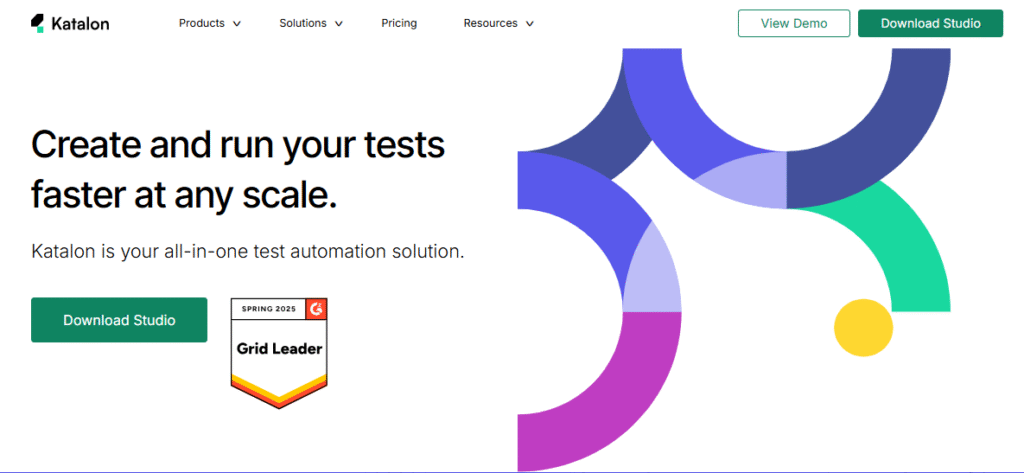
Katalon Studio is a versatile automation tool that supports web, API, mobile, and desktop apps. Its codeless test creation, powered by record-and-playback and keyword-driven testing, makes it ideal for teams of all skill levels. With built-in CI/CD integrations and detailed reporting, Katalon helps streamline testing across the software lifecycle.
Type: Low-Code / Codeless
Best For: Web, API, desktop, and mobile automation
Highlights:
- Record & playback functionality
- Keyword-driven testing
- AI-powered object recognition
- CI/CD and Git integration
- Built-in test reporting dashboard
Pros:
- Wide tech stack support
- Intuitive UI for manual testers
- Supports scripting if needed
Cons:
- Slight learning curve
- Limited collaboration features on free tier
Use Case:
Great for teams that want a blend of codeless automation testing and optional scripting.
2. TestCraft (Tricentis) – Tool for Codeless Test Automation
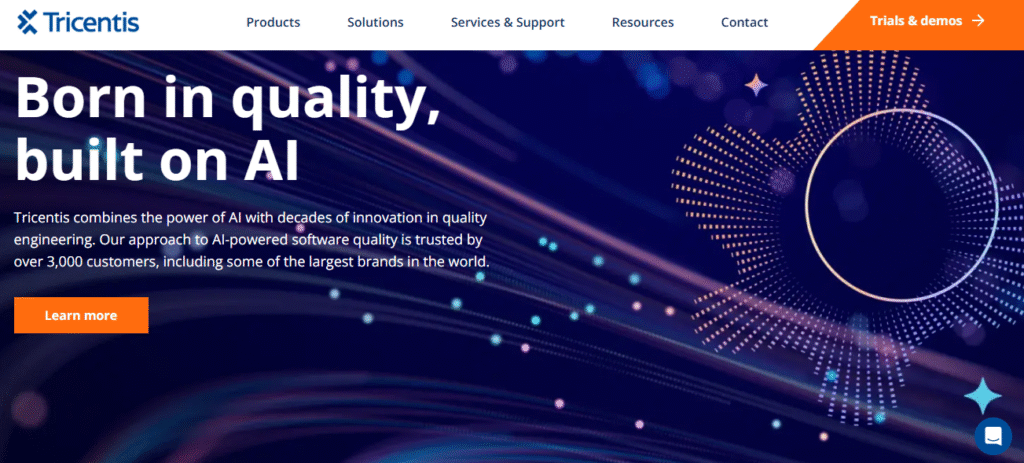
Tricentis provides a visual platform for Selenium-based test automation. With its drag-and-drop interface, QA teams can design robust test flows without coding. Auto-healing features reduce maintenance, while cross-browser testing ensures reliability. It’s a strong choice for enterprises needing scalable, regulation-friendly testing solutions.
Type: Codeless
Best For: Selenium-based UI test automation
Highlights:
- Drag-and-drop interface
- AI maintenance engine
- Visual flow for test creation
- CI/CD support and real-time dashboards
Pros:
- Highly stable tests
- Built on Selenium without writing code
- Great for continuous testing
Cons:
- Web apps only
- The price may not suit small teams
Use Case:
Ideal for enterprises looking for scalable automation testing tools without coding.
3. KaneAI (LambdaTest) – Codeless Testing Tool
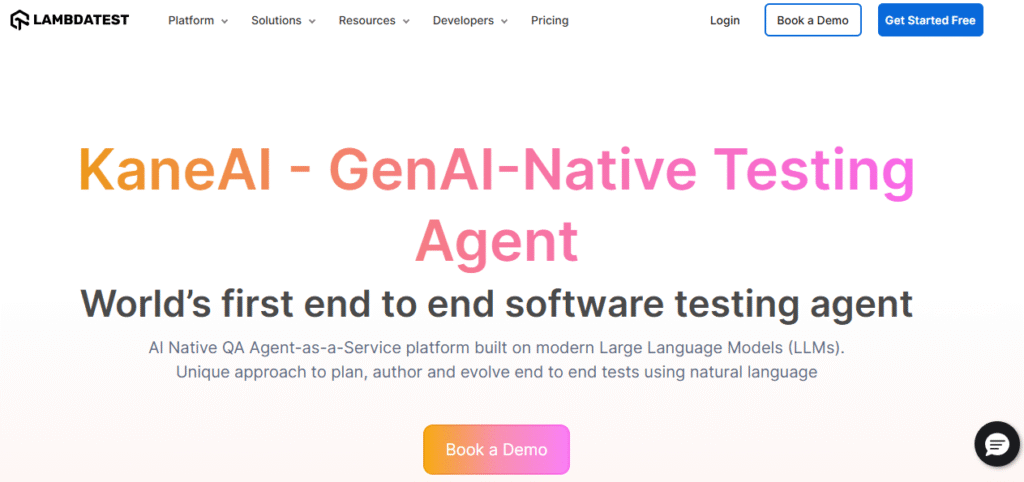
KaneAI is a GenAI-powered testing platform designed for modern agile teams. It allows users to write tests using natural language and automatically generates reusable, smart test steps. Perfect for teams seeking intelligent automation, KaneAI reduces manual work while improving coverage across UI and API layers.
Type: GenAI-native codeless automation
Best For: Scalable UI + API testing using natural language and Smart regression and test creation
Highlights:
- Natural Language Processing (NLP)
- Predictive test suggestions
- Self-healing tests
- Visual and data validation support
Pros:
- Very beginner-friendly
- Reduces flaky tests with AI
- Smart debugging features
Cons:
- Not suitable for low-level system testing
- Newer player in the market
Use Case:
Excellent for teams looking to explore no code test automation with AI-driven intelligence.
4. BrowserStack Automate + Test Observability
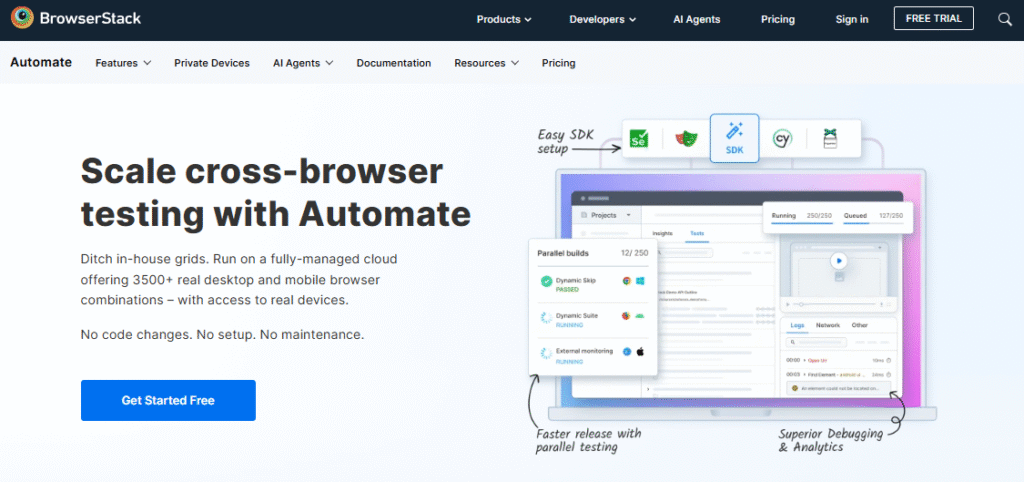
BrowserStack Automate offers codeless and low-code testing with real browser/device access in the cloud. Its test recorder, visual validation, and self-healing features make it easy for both beginners and advanced testers. Ideal for cross-platform testing and rapid feedback within CI/CD workflows.
Type: Codeless and Low-Code
Best For: Cross-browser and real device automation
Highlights:
- Real device testing
- Smart visual testing
- Screenshot comparison
- Parallel test execution
- Self-healing and visual test creation
- Test observability and debugging tools
Pros:
- Access to 3,000+ devices
- Built-in integrations with test frameworks
- Strong support for CI/CD
Cons:
- Cloud latency
- Limited advanced scripting
- UI test recorder is a basic
- High pricing for scale
Use Case:
Perfect for teams that need scalable codeless automation testing tools across multiple browsers and OS combinations.
5. CloudQA – Codeless Test Automation Solution
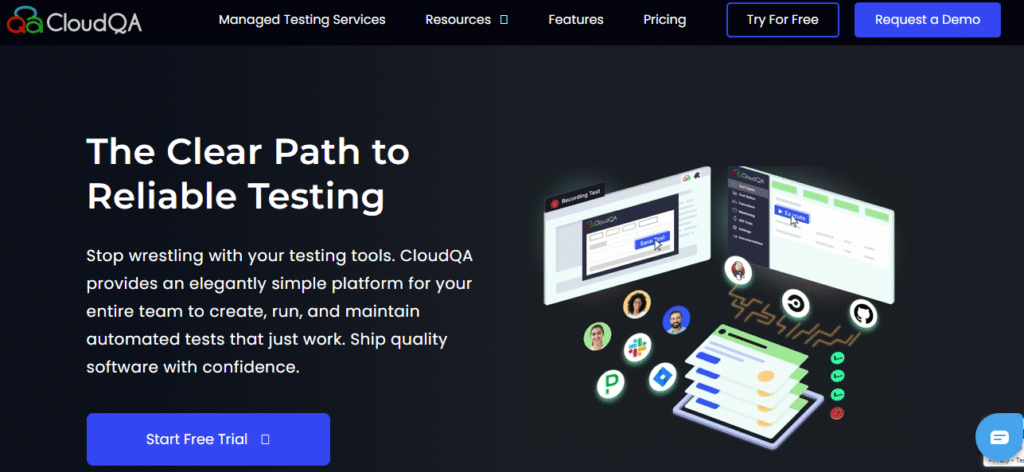
CloudQA simplifies web application testing with its intuitive scenario builder and visual interface. It supports performance testing, regression automation, and test reuse without requiring any coding. Designed for SMBs and QA teams looking for efficient test execution and quick deployment cycles.
Type: Codeless
Best For: Web automation and performance testing
Highlights:
- Scenario builder
- Record-and-play tests
- Performance + load testing
- Visual editing of test steps
- Easy test reuse
- Cross-browser testing in the cloud
Pros:
- Affordable pricing tiers
- Simple UI
- Strong reporting
- Easy for manual testers
- Good monitoring integrations
Cons:
- Limited mobile support
- UI can be less modern
Use Case:
Great for small to mid-size QA teams adopting codeless automation testing in web-based projects.
6. SoapUI (ReadyAPI)
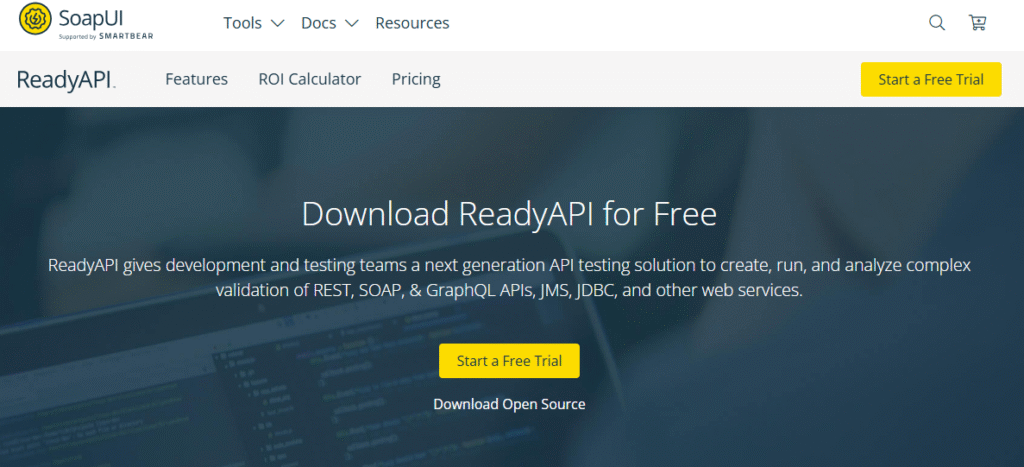
SoapUI is a powerful tool for codeless API testing. It supports REST, SOAP, and GraphQL protocols with visual workflows, making it easy for teams to test backend services without code. With features like load testing and CI integration, it’s ideal for developers and testers alike.
Type: Low-Code / Codeless
Best For: API test automation
Highlights:
- REST, SOAP, and GraphQL support
- Security and load testing
- Drag-and-drop workflows
- Reporting and assertions builder
Pros:
- Open-source base, extensible
- Powerful for API testers
- Easy test reuse across services
- Strong community and plugins
Cons:
- Learning curve for UI, analytics is limited
- Not for UI testing
- A paid version is needed for full capabilities
Use Case:
Backend-focused teams prioritize API health. Ideal for QA teams that focus on backend and API tests with little or no scripting.
7. Kobiton
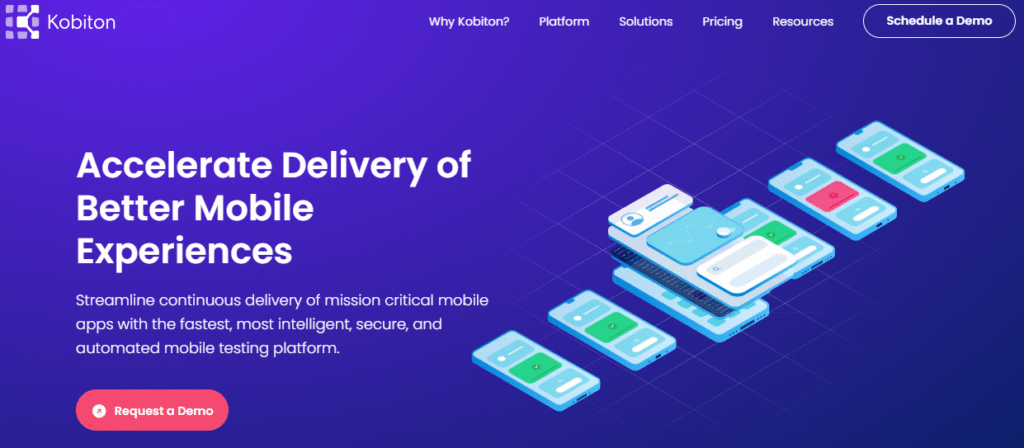
Kobiton delivers real-device testing for mobile apps with both manual and automated options. Its codeless automation and AI-powered visual testing make it a top pick for mobile QA teams. You can run tests in parallel across devices, track performance, and ensure seamless user experience at scale.
Type: Codeless + AI
Best For: Mobile test automation on real devices
Highlights:
- Real device cloud
- Mobile-first testing UI
- Appium-compatible
- Scriptless automation with Intelligent Test Automation
- Visual + performance testing
- Real device testing lab access
- Appium-based framework compatibility
Pros:
- Scalable and mobile-first, parallel execution
- No coding for mobile test automation
- Real-time performance monitoring
- Easy to scale tests across devices
Cons:
- Higher pricing, cloud dependency
- Desktop testing not supported
Use Case:
Great for mobile app QA with real-device access. Perfect for mobile-first companies wanting no-code test automation across Android and iOS.
Endtest
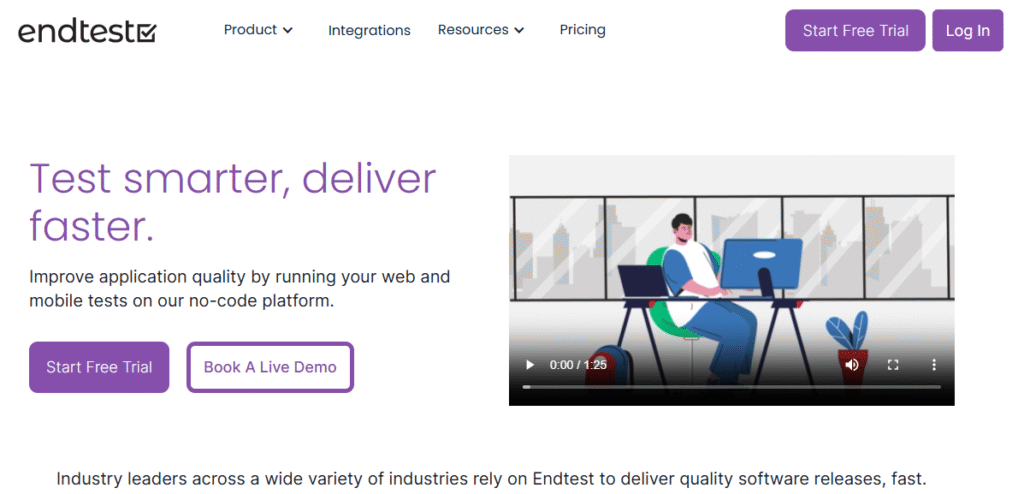
Endtest is a codeless web application testing platform that allows teams to automate test creation, execution, and maintenance without writing any code. It features a powerful test recorder, cloud-based execution, and smart maintenance options.
Type: Web-based Codeless Testing Platform
Best For: Teams looking for a simple, intuitive test automation tool with strong support for CI/CD and real-time test monitoring.
Highlights:
- No-code test creation using visual recorder
- Cloud execution on real browsers
- Real-time test monitoring
- Parallel test execution
- Supports test scheduling and version control
Pros:
- Clean and beginner-friendly interface
- Easy integration with CI/CD pipelines
- Visual test editing and maintenance
- Scalable for multiple test runs
Cons:
- Limited customization for advanced logic
- No native support for mobile testing
Use Case:
Perfect for agile QA teams that need fast web test automation and seamless integration with DevOps workflows, without worrying about test infrastructure setup.
Virtuoso
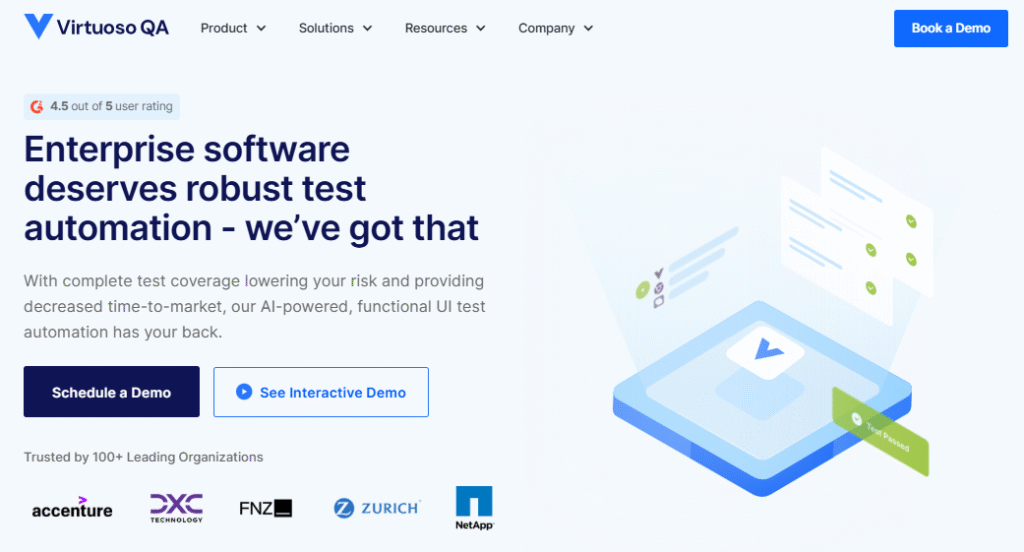
Virtuoso is an advanced codeless automation tool that uses Natural Language Processing (NLP) to let users write test cases in plain English. It supports intelligent automation and continuous testing at scale.
Type: AI-Powered Codeless Test Automation
Best For: Teams seeking advanced automation using NLP with support for cross-browser and AI-driven test maintenance.
Highlights:
- NLP-based test scripting (write tests in plain English)
- AI for auto-healing broken tests
- Cloud-based parallel execution
- Advanced test data generation
- DevOps and CI/CD tool integration
Pros:
- Intuitive for non-technical users
- Reduces test flakiness through auto-healing
- Strong analytics and reporting dashboard
Cons:
- May require initial setup and training
- More expensive than lightweight tools
Use Case:
Best suited for enterprise teams that want to scale test automation while enabling non-technical stakeholders to participate in quality assurance using human-readable scripts.
Reflect
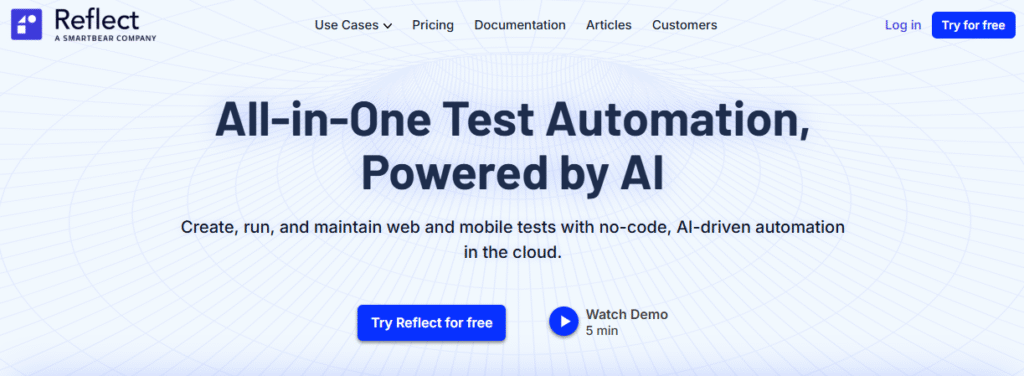
Reflect is a codeless, web automation platform that uses a browser-based recorder to create reliable UI tests without code. It features auto-healing, visual validation, and parallel cloud execution.
Type: Web UI Codeless Testing Tool
Best For: QA teams that need fast UI test automation for web apps, especially those with frequent UI changes.
Highlights:
- Browser-based test recorder
- Auto-healing tests
- Visual regression testing support
- Parallel test runs in the cloud
- No browser extensions required
Pros:
- Very easy to get started
- Minimal setup, browser-native
- Good support for visual/UI changes
Cons:
- Limited support for mobile or desktop apps
- Less customizable for complex workflows
Use Case:
Ideal for startups and product teams that need quick UI test coverage for web apps with rapidly changing interfaces and minimal DevOps effort.
How to Choose the Right Codeless Automation Tool
Not all tools are created equal. Consider these key factors before choosing:
- Usability: Look for an intuitive UI that supports drag-and-drop workflows.
- Ease of Use: Prioritize tools with intuitive UIs and low learning curves
- Technology Support: Ensure compatibility with web, mobile, or API testing.
- Platform Support: Ensure compatibility with mobile, web, and desktop environments
- CI/CD Integration: Choose tools that integrate easily into your DevOps pipeline.
- Scalability: Can it handle thousands of tests across environments?
- Security: Check for access control, encryption, and compliance support.
- Support & Community: Reliable documentation, active forums, or live support help resolve issues faster.
- Budget Fit: Compare licensing models and feature costs with your long-term goals.
Pick a tool that balances ease of use with flexibility and growth.
Hybrid Testing: Best of Both Worlds
While codeless automation speeds up test creation, complex scenarios may still require traditional code. That’s why many teams adopt a hybrid testing approach using a mix of manual, coded, and codeless methods.
- Prefer to use manual testing for exploratory and usability testing
- You can use coded testing for complex, dynamic validations
- Use codeless testing for routine UI, regression, and data-driven tests
This combination maximizes coverage, minimizes effort, and aligns with agile development.
Final Words
Codeless test automation has rapidly matured into a game-changing approach for modern QA teams. With tools like Katalon, TestCraft, BrowserStack, and now newer entrants like Endtest, Virtuoso, and Reflect, teams have more power than ever to build scalable, intelligent, and user-friendly test suites—without writing a single line of code.
Whether you’re a manual tester looking to automate without coding or a product team aiming for faster release cycles, codeless tools offer unmatched simplicity, speed, and collaboration.
By carefully selecting a platform that fits your needs and following best practices, you can accelerate your automation journey, reduce maintenance costs, and deliver higher-quality software faster.
Who can use codeless automation tools?
Anyone involved in the software development process—manual testers, business analysts, product owners, or QA engineers can use codeless tools. They are especially helpful for teams with limited coding experience.
Is codeless test automation suitable for complex test cases?
Yes, modern codeless tools support features like conditional logic, loops, API testing, and CI/CD integration. For highly complex or backend-heavy tests, combining codeless tools with traditional frameworks may be more effective.
What are the benefits of using codeless automation tools?
Key benefits include faster test creation, easier maintenance, broader team collaboration, reduced cost, and quicker release cycles. Many tools also offer visual testing, AI auto-healing, and built-in analytics.
Are codeless automation tools reliable for production-grade testing?
Yes. Tools like Katalon Studio, BrowserStack, and Virtuoso offer enterprise-grade stability, integration, and scalability. They are widely trusted across industries for UI, API, and regression testing.
Do codeless tools support mobile and API testing?
Many codeless platforms like Kobiton, Katalon, and TestProject support mobile automation. Others like SoapUI and Virtuoso offer robust API testing—without requiring code.
How do I choose the right codeless test automation tool?
Consider your team’s skill level, target platforms (web, mobile, API), integration needs, budget, and scalability. Look for features like visual workflows, test data management, CI/CD compatibility, and responsive customer support.
